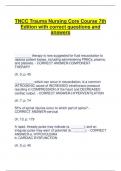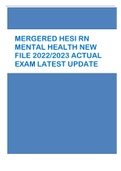TNCC Trauma Nursing Core Course 7th
Edition with correct questions and
answers
_________ therapy is now suggested for fluid resuscitation to
replace patient losses, including administering PRBCs, plasma,
and platelets. - CORRECT ANSWER-COMPONENT
THERAPY
ch. 5, p. 45
__________, which can occur in resuscitation, is a common
IATROGENIC cause of INCREASED intrathoracic pressure
resulting in COMPRESSION of the heart and DECREASED
cardiac output. - CORRECT ANSWER-HYPERVENTILATION
ch. 7, p. 74
55% of spinal injuries occur to which part of spine? -
CORRECT ANSWER-cervical
ch. 13, p. 179
A rapid, thready pulse may indicate (a. _______), and an
irregular pulse may warn of potential (b. _______). - CORRECT
ANSWER-a. HYPOVOLEMIA
b. CARDIAC DYSFUNCTION
ch. 5, p. 45
,ABGs provide values of oxygen, CO2 and base excess, which
are... - CORRECT ANSWER-Reflective endpoint
measurements of the effectiveness of cellular perfusion,
adequacy of ventilation, and the success of the resuscitation.
An abnormal base deficit may indicate poor perfusion and
tissue hypoxia, which results in the generation of hydrogen ions
and metabolic acidosis.
ch. 5, p. 46
Activation of the SYMPATHETIC NERVOUS SYSTEM causes
the ADRENAL glands to release TWO catecholamines -
EPINEPHRINE and NOREPINEPHRINE. These cause... -
CORRECT ANSWER-- HIGH levels of EPINEPHRINE cause
smooth muscle relaxation in the airways and causes arteriole
smooth muscle contractility (potentiating inotrophic effect). EPI
also INCREASES heart rate (positive chronotrophic effect),
peripheral vasocontriction, and glycogenolysis (breakdown of
glycogen stores in liver into glucose for cellular use)
- NOREPINEPHRINE increases heart rate, vascular tone
through alpha-adrenergic receptor activation, and blood flow to
skeletal muscle and triggers the release of glucose from energy
stores.
ch. 7, p. 77
Additional history includes the following (MIST mnemonic)
prehospital report: - CORRECT ANSWER-- MOI
- Injuries sustained
- Signs and Symptoms (in the field)
- Treatment (in the field)
ch. 5, p. 47
,All open fractures are considered contaminated due to
exposure to the environment and are at risk for infection. These
sites of injury have poor wound healing with a risk of.... -
CORRECT ANSWER-OSTEOMYELITIS and SEPSIS
ch. 14, p. 197
Anterior cord syndrome - CORRECT ANSWER-loss of pain
and temperature sensation with weakness, paresthesia, and
urinary retention
ch. 13, p. 182
AORTIC DISRUPTION - CORRECT ANSWER-Assessment
findings
- Fractures of sternum, first or second rib or scapula
- CARDIAC MURMURS
- BACK, CHEST PAIN
- UNEQUAL EXTREMITY PULSE STRENGTH or BLOOD
PRESSURE (Significantly greater in upper extremities)
- HYPOTENSION
- TACHYCARDIA
- SKIN CHANGES: diaphoresis, pallor, cyanosis
- PHARAPLEGIA (due to disruption of spinal perfusion from
aortic injury)
- Radiograph findings include- left hemothorax, right-sided
tracheal deviation, widened mediastinum
Interventions
- Prepare for surgery or angiography
- Consider massive transfusion protocol
ch. 11, p. 146
Are the lumen contents of the small bowel considered sterile?
What is the pH? - CORRECT ANSWER-neutral pH, and sterile
, ch. 12, p. 164
As ICP rises, CPP ________, resulting in cerebral ischemia,
hypoxemia, and lethal secondary insult. - CORRECT
ANSWER-DECREASES
Ch. 9, p. 109
As shock progresses, primary goal of the body is to maintain
perfusion to vital organs. Sympathetic stimulation has little
effect on the cerebral and coronary vessels since they are
capable of autoregulation. Cerebral autoregulation maintains a
constant... - CORRECT ANSWER-cerebral vascular blood flow
as long as the MAP is maintained between 50-150... when
autoregulation in the brain fails, perfusion becomes dependent
solely on pressure.
ch. 7, p. 78
Assess pupils for... - CORRECT ANSWER-Equality, shape,
and reactivity (PERRL)
ch. 5, p. 45
Assessment findings for MILD, MODERATE, and SEVERE
TRAUMATIC BRAIN INJURY INCLUDE: - CORRECT
ANSWER-MILD
- GCS 13-15
- Brief (<30 min) LOC
- POST-TRAUMATIC AMNESIA < 24 hours
- No change on neuron aging studies
MODERATE
- GCS score 9-12
- Wide variety of symptoms, including ALTERATIONS IN
CONSCIOUSNESS, CONFUSION, AMNESIA, and FOCAL
NEUROLOGICAL DEFICITS





